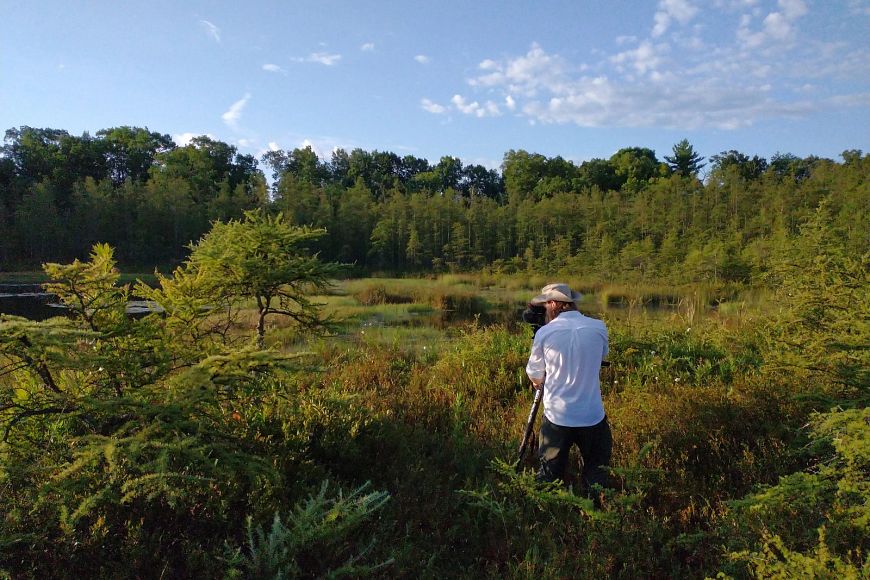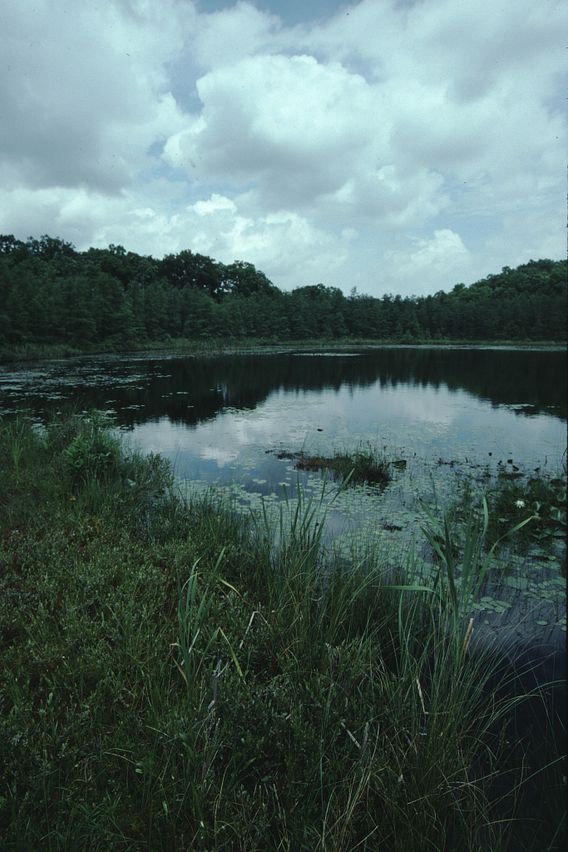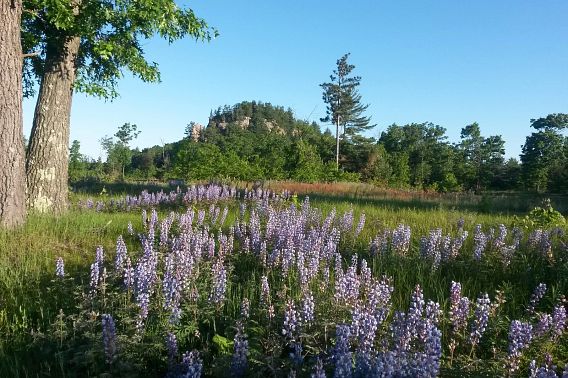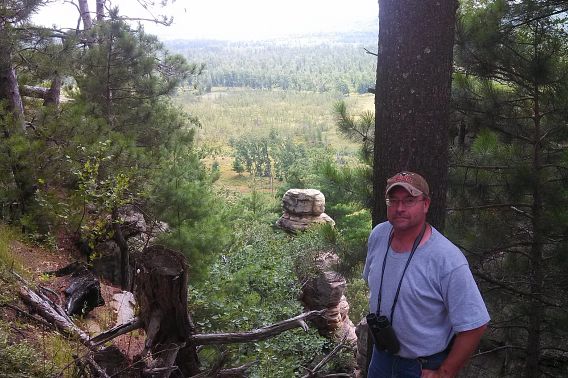Preserve, protect, appreciate
State Natural Areas Program strategizes to safeguard natural heritage lands
 THOMAS MEYERJames Donovan of PBS Wisconsin films Beulah Bog State Natural Area for a recent documentary film.
THOMAS MEYERJames Donovan of PBS Wisconsin films Beulah Bog State Natural Area for a recent documentary film.Lisa Gaumnitz
On a warm, sunny March day, honeycomb ice floats over mats of last season’s pickerel weed at Beulah Bog State Natural Area in Walworth County, masking the spongy peat beneath.
Short tamarack trees with cones hanging from stunted branches ring the outer edge of the bog lake, and taller tamaracks reach skyward away from the shoreline.
A single puff of tawny cotton grass, a welcome holdover from last year’s growth, clings to its stalk, while the blood-red funnels of pitcher plants poke through the ice, soon to unfurl a new set of insect-trapping leaves in a bed of sphagnum moss.
The ancient bugling calls of sandhill cranes rise as two pairs take off.
Spring is coming to one of Wisconsin’s southernmost bogs, bringing new life to a unique landscape sculpted by immense forces over thousands of years and now protected as part of the Wisconsin State Natural Areas Program.
The SNA Program celebrates 70 years in 2021, making it the nation’s oldest statewide system of natural areas. It also is the largest — nearly 700 jewels sparkling across Wisconsin with the sole statutory purpose of saving for now and future generations a living record of diverse prairies, forests, wetlands and other natural communities in the state.
For Wisconsin, these areas represent the legacy of geologic forces, geographic destiny and immutable time, and the collective commitment to caring for these special places.
The last 30 years in particular have challenged this natural heritage, as invasive species, climate change, historic levels of white-tailed deer, encroaching development and other human-caused stressors collectively pose an existential threat to many of these sites and a seemingly endless task for their caretakers.
“These places that still retain a semblance of Wisconsin’s pre-settlement landscapes and the native species they support are in danger of winking out,” said Thomas Meyer, the DNR conservation biologist who has played a big role in shaping the system over the last three decades.
Despite the challenges, Meyer and other DNR staff plus 60 partners like The Nature Conservancy, the U.S. Forest Service and The Prairie Enthusiasts that own State Natural Areas aren’t throwing in the towel. They’re tooling up and evolving their approaches to meet these challenges.
A new strategic plan has been created to save these diverse habitats, many of them globally rare, by working smarter.
New technologies developed with partners are helping prioritize the identification, protection and management of natural areas in an era of limited resources and changing environmental conditions. Grants, donations from the Natural Resources Foundation of Wisconsin and other organizations, and thousands of hours from volunteers are adding to the work that can get done at dozens of sites.
“We can’t use the same protection strategies they did 70 years ago, or even 35 years ago when the last strategic plan was created,” Meyer said. “Even in that seemingly short period of time, the impacts to the environment have changed, sometimes significantly.”
SIZING THINGS UP
Conservation giants Aldo Leopold, John Curtis and Albert Fuller planted the seeds for the State Natural Areas Program in the 1940s, compelled by their concern Wisconsin was losing its vast southern prairies and wetlands and other places they could take students to see native flora and fauna.
Plant species, not whole, functioning ecosystems, were their focus. That was reflected in 1951 when the State Legislature created the State Board for the Preservation of Scientific Areas and the group set the minimum size for protecting prairie at 1 acre and 10 acres for woods.
If a site harbored a diversity of native tree and plant species, even if it was a tiny remnant of a previously more widespread ecosystem, it was deemed worthy of protection.
“The scientific thinking has evolved tremendously since then,” Meyer said. “Those little places just don’t cut it anymore.
“What we’ve been trying to do for a few years is to protect not only small specific examples of a given natural community — like a dry prairie, for example — but the full diversity of community types that all reside in the same larger landscape and flow from one to another.”
Nick Miller, scientific director at The Nature Conservancy, said this landscape-scale approach recognizes that some wildlife species need larger habitats, such as many warblers that live only deep in large blocks of forest.
Other species need more than one habitat to survive and require room to roam. State-threatened wood turtles, for example, need streams for hibernating, forests for foraging and sand for nesting.
And all species are part of, and depend on, a larger community of species linked across larger landscapes.
“All of these factors and more have led us to protect larger habitats, habitats that are connected and enable species to move across Wisconsin’s landscapes and also to work with landowners outside of State Natural Areas to minimize impacts that extend into preserves,” Miller said. “Partnering with farmers on water quality is one example.”
 THOMAS MEYERBeulah Bog State Natural Area, one of the state's southernmost bogs, requires special care to ensure it can adapt to future climate conditions.
THOMAS MEYERBeulah Bog State Natural Area, one of the state's southernmost bogs, requires special care to ensure it can adapt to future climate conditions.SHIFT FOCUS TO SURVIVE CHANGE
That approach is especially important as climate change means some species will have to move, perhaps long distances, to find the conditions they need to survive under potentially warmer and wetter settings. Some already are.
The Nature Conservancy, with partners including science experts from the DNR, developed a new landscape-scale vision for conservation called the Resilient and Connected Network (also known as Conserving Nature’s Stage).
Together, they’ve produced maps and an online tool that identify the places across Wisconsin and the U.S. where species have the greatest chance of surviving, as well as habitat corridors that will give species access to these resilient areas.
This vision for climate resilience is now guiding where and how The Nature Conservancy protects and manages lands, and where they’ll designate their next nature preserves, Miller said.
Those tools are helping the DNR shift in its new strategic plan from trying to keep all State Natural Areas looking like they did prior to Euro-American settlement to a more pragmatic goal — “less diorama and more dynamic,” the plan’s drafters said.
“We envision a system of State Natural Areas that protects the full range of Wisconsin’s natural heritage, addresses environmental challenges through stewardship and is valued by all generations.”
CLIMATE IMPACTS AFFECT PLANNING
Meyer and other conservation biologists and SNA managers are now turning the new strategic plan into a boots-on-the-ground implementation guide for managing the system.
For years, DNR Natural Heritage Conservation staff have been working as part of the Wisconsin Initiative on Climate Change Impacts to analyze how climate change will impact State Natural Areas and Wisconsin’s rare species and to weigh adaptations. More recently, workshops have helped SNA managers translate the science into action at specific sites, including Beulah Bog.
SNA crew members Trent Leaf and Mackenzie Manicki and NHC colleague Amy Staffen teamed with the Northern Institute of Applied Climate Science to dig into likely climate changes and potential threats to the bog and ways to adapt management.
Survival of this southern bog will depend largely on what happens on surrounding land. There, upland oak savanna with scattered white and bur oaks and an understory of native plants vie with non-native buckthorn and honeysuckle and are fragmented by subdivisions flanking Beulah Bog’s southern border.
More precipitation is predicted for the future climate here. That raises concerns of increased runoff from uplands carrying nutrients and sediment into the bog that could disturb the water chemistry supporting this unique assemblage of acid-tolerant plants, said Pete Duerkop, the district ecologist with responsibility for the site.
To counter that threat, crews carefully place and angle firebreaks on upland oak savanna that surrounds the bog to minimize gullying. Prescribed fire in the savanna will in turn boost a healthy, native plant understory and filter runoff.
Warmer temperatures are expected to goose the growth of brush and invasive species, limiting oak regeneration and reducing the vigor of native plants in the understory. To help maintain the upland oak communities, SNA crews conduct regular prescribed burning and brushing.
SNA crews and Kettle Moraine Land Trust volunteer stewards will keep a keen eye on invasive species in an attempt to control them before they get a foothold.
Managers won’t be able to counteract all climate change impacts. Tamaracks here are already at the southern edge of their range, so increasing temperatures may reduce their extent in the four kettle bogs. And the thick layer of peat created when the bog plants decompose under cold, anoxic conditions may diminish with the higher temperatures forecast.
By tending to uplands, adapting management where possible and partnering with land trust volunteer stewards, managers hope to build healthy surrounding ecosystems and resiliency.
 JON ROBAIDEKQuincy Bluff and Wetlands State Natural Area near Mauston features a suite of rare ecosystems.
JON ROBAIDEKQuincy Bluff and Wetlands State Natural Area near Mauston features a suite of rare ecosystems.BROKEN DREAMS TO GLOBAL TREASURE
In Adams County, another State Natural Area features one of the program’s best examples of landscape-scale management.
Quincy Bluff and Wetlands SNA is a short detour off Interstate 90 near Mauston but feels a world away, down country roads past a smattering of houses and potato fields. DNR regional ecologist Jon Robaidek and conservation biologist Josh Karow are responsible for this site and 17 others in the area.
“This is an amazing property, the most beautiful in the state,” said Karow, who lives 2 miles away and hunts and hikes the area when he’s not managing the habitat.
“You can stand on the property and not see anything that is man-made except for the fire tower, which will be coming down. The property is 7 miles long and 3 miles wide and uninterrupted by roads.”
At 6,700 acres, Quincy is the third largest State Natural Area in the state. Pieced together by the DNR over the last 30 years, it was crowned in 2013 by The Nature Conservancy’s donation of 1,700 acres and an endowment of $178,000 to care for it, Robaidek said.
Quincy’s location yields an amazing diversity of habitats, species and landforms. It is found on the lakebed of former Glacial Lake Wisconsin and near the ecological tension zone where Wisconsin’s northern mixed forest transitions to its southern prairies, with plants and animals of both intermingling.
When glaciers receded and the ice dam holding the glacial lake broke some 10,000 years ago, the lake drained, leaving a flat, sandy plain with scattered sandstone buttes and mesas rising 100 to 200 feet above the plain, including the namesake Quincy Bluff, which extends 2 miles.
The sandy soils were poor for growing crops and rich in broken dreams. The property’s maintenance shed once housed a private fish farm raising minnows. A commercial wild rice operation, cranberry bog and practice area for water skiers have all come and gone.
A large aerial map inside the maintenance shed outlines the restoration challenge and promise ahead with a mix of prescribed burns, brushing, selective timber harvests and native plant seeding. Yellow outlines show the habitat types Robaidek and Karow are aiming for. “Barrens to sand prairie. Oak woodland. Oak to oak-pine barrens. Old-growth.”
Oak savannas, prairies and barrens are all globally rare, and in Wisconsin, less than one-tenth of 1% of the acreage of these ecosystems present at statehood remains.
“We’re caring for and restoring ecosystems that are rarer than many you’d see in the Amazon rainforest,” Karow said. “People don’t grasp the truly special and incredibly rare nature of a place like this.”
 JOSH KAROWJon Robaidek, one of the property managers at Quincy Bluff and Wetlands, enjoys the view from Lone Rock, which includes a panorama of the surrounding landscape.
JOSH KAROWJon Robaidek, one of the property managers at Quincy Bluff and Wetlands, enjoys the view from Lone Rock, which includes a panorama of the surrounding landscape.A SUITE OF ECOSYSTEMS
Prescribed burning is one good way to achieve certain management goals for Quincy.
“We are trying to return fire to where it used to be before settlement,” Robaidek said. “With our having a large site and sole ownership, we can return fire to a larger area with multiple habitats with one big burn.”
A section of young sand prairie shows how the restoration effort can have gratifyingly quick results. It was a fallow farm field until Robaidek and Karow conducted a prescribed burn and seeded the field with 30 species of native grass and wildflower seed collected earlier from the property itself.
Wetlands are maintained as habitat for migrating waterfowl and shorebirds stopping over en route to Canada. A 1,000-acre sedge meadow gives way to undulating hills with scattered jack pine, Hill’s oak and a variety of shrubs.
Grasses and plants characteristic of barrens and sandy prairies are found here again. Last summer, when Robaidek and Karow were collecting seed, they discovered a Karner blue butterfly, an endangered species.
“After all this barrens work, it was pretty rewarding to find it here on the property,” Robaidek said.
At the top of Lone Rock, one of the property’s sandstone buttes, a panoramic 360-degree view showcases the variety of habitats, along with the crew’s handiwork. For Robaidek and Karow, what they do here is a labor of love.
“I’m just a small blip in time in the management of this thing,” Robaidek said. “We’re not going to see the end of this, but we do see the changes we are making to the landscape.”
The work will go on long into the future, Karow added.
“We’re painting a 200-year picture here,” he said. “All we can do right here is the best we can to push this to the next level and hope the next people keep pushing it in the same direction.”
Lisa Gaumnitz is a natural resources educator and program and policy analyst for the DNR.
MORE ABOUT THE SNA PROGRAM
The perils and promise of State Natural Areas are evident in Beulah Bog and Quincy Bluff and Wetlands, two SNAs whose beauty and uniqueness are shown in unprecedented aerial and on-the-ground video footage in the new PBS Wisconsin documentary “Wisconsin’s Scenic Treasures: Southern Vistas.” Guided by DNR conservation biologist Thomas Meyer, the show features 15 State Natural Areas filmed last summer. Stream it on-demand at PBS Wisconsin and on the free PBS app.
Nearly all State Natural Areas are open to the public to enjoy bird watching, hiking, hunting and fishing. Most are largely undeveloped and do not have restrooms, trails and other facilities like state parks. Check the DNR website for details on the SNA Program and to search for SNA locations statewide.

